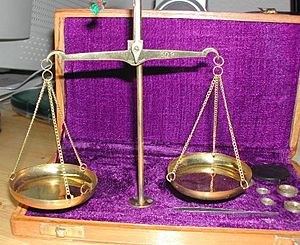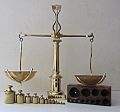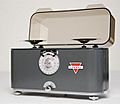Beam balance facts for kids
A beam balance is a cool tool that helps us measure how much "stuff" is in an object. This "stuff" is called mass. Imagine a seesaw with two trays. You put an object on one tray and add special weights to the other tray until the seesaw is perfectly level. When it's level, you know the mass of your object! It's like a simple lever that helps us compare how heavy things are.
Contents
What is Mass?
When we talk about a balance, we're usually measuring mass. Mass is how much material or "stuff" an object has. It's different from weight, which is how strongly gravity pulls on an object. Your mass stays the same whether you are on Earth or the Moon. But your weight would be much less on the Moon because it has less gravity!
How a Beam Balance Works
A beam balance works by comparing an unknown mass to known masses.
- It has a central pivot point, like the middle of a seesaw.
- There are two arms of equal length extending from this pivot.
- At the end of each arm, there's a pan or a hook to hold things.
- You place the object you want to measure on one pan.
- Then, you add known weights (like little metal blocks with numbers on them) to the other pan.
- You keep adding or removing weights until the beam is perfectly level. This means both sides have the same mass.
- By adding up the known weights, you find the mass of your object!
Types of Balances
Over time, people have invented many different kinds of balances and scales. They all help us measure mass or weight.
Traditional Balances
- Pan Balance: This is the classic beam balance we just talked about. It's very accurate for comparing masses.
- Steelyard Balance: This type uses a sliding weight along a marked beam. You move the weight until the beam balances, and then you read the mass from the scale on the beam. It's good for measuring heavier things without needing many small weights.
- Roberval Balance: This balance looks a bit different. It has a special design with pivots that make it easy to use. You can place objects anywhere on the pan, and it will still give an accurate reading. This makes it very convenient for things like kitchen scales.
- Torsion Balance: Instead of a pivot, this balance uses a twisted wire or band. When you put a mass on it, the wire twists, and the amount of twist tells you the mass. These can be very sensitive and accurate.
Modern Scales
- Digital Scales: Many scales today are digital. They don't use weights or a balancing beam. Instead, they use electronic sensors called strain gauges. When you put something on the scale, the sensor measures the tiny change in pressure. This pressure is then converted into a digital number that shows the mass or weight. You see these in kitchens and grocery stores.
- Bathroom Scales: These are usually mechanical or digital. Mechanical ones often use springs inside. When you stand on them, the springs compress, and a dial shows your weight. Digital ones use strain gauges, just like other digital scales.
Why Balances are Important
Balances and scales have been used for thousands of years.
- Trade: In ancient times, people used balances to make sure they were getting a fair amount of goods when trading. They are still used today in shops and markets.
- Science: Scientists use very precise balances to measure tiny amounts of chemicals or materials in experiments. This helps them be very accurate in their work.
- Cooking: Many recipes require exact amounts of ingredients, and kitchen scales help us measure them perfectly.
- Health: Doctors and nurses use scales to measure body weight, which is important for health checks.
Balances are simple but powerful tools that help us understand the world around us by measuring how much "stuff" things contain.
Images for kids
-
Two 10-decagram masses
-
Scales used for trade purposes in the United States, as this scale at the checkout in a cafeteria, are inspected for accuracy by the FDACS's Bureau of Weights and Measures.
-
Weighing dishes from the island of Thera, Minoan civilization, 2000–1500 BC
-
Assyrian lion weights (8th century BC) in the British Museum
-
Emperor Jahangir (reigned 1605–1627) weighing his son Shah Jahan on a weighing scale by artist Manohar (AD 1615, Mughal dynasty, India).



















